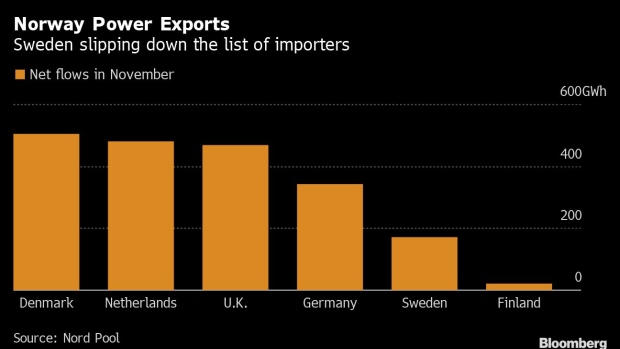Dec 6, 2021
Europe’s Thirst for Electricity Spurs Nordic Grid Blockade
, Bloomberg News

(Bloomberg) --
A spat over electricity supplies is heating up in northern Europe.
Sweden is blocking Norway from using its grids to transfer power from producers throughout the region. That’s angered Norway, which in turn has cut flows to its Nordic neighbor.
The dispute has built up around the use of cross-border power cables, which are a key part of Europe’s plans to decarbonize since they give adjacent countries access to low-carbon resources such as wind or hydropower. The electricity flows to wherever prices are higher -- without interference from grid operators -- but in the event of a supply squeeze, flows can be stopped.
Sweden moved to safeguard the security of its grid after Norway started increasing electricity exports through huge new cables to Germany and the U.K. Those exports at times have drawn energy away from Sweden, resulting in the country’s system operator cutting capacity at its Nordic borders, preventing exports but also hindering imports, which it relies on to handle demand spikes during winter.
“This is not a good situation in the long run,” Christian Holtz, a energy market consultant for Merlin & Metis AB.
Norway hit back last week by cutting flows to Sweden, this will prioritize better paying customers in Europe giving them access to its vast hydro resources at the expense of its Nordic neighbors.
By partially closing its borders Sweden can’t access imports either, which it relies on to handle demand spikes during the coldest days of the winter.
The Swedish grid manager Svenska Kraftnat has reduced export capacity at cables across its borders by as much as half this year to keep operations secure. Finland and Denmark rely on imports too and the cuts will come at a cost for millions of homes and industries across the four nations already contending with record electricity rates.
Finland and Denmark want the European Union to end the exemption to regulations that make such reductions possible in the first place.
“Imports from our neighboring countries ensure adequacy at times of peak consumption,” said Reima Paivinen, head of operation at the Finland’s Fingrid. “The recent increase in the electricity price throughout Europe does not directly affect the adequacy of electricity, but prices may rise dramatically for short periods.”
Svenska Kraftnat says it’s not political -- it has no choice but to cut capacity until its old grids are expanded to handle the new direction of flows. That could take at least until 2030 to complete, it said earlier this year. At the same time, Norway halving available export capacity to about 1,200 megawatts will increase risk of shortages.
“If we need more we will have to count on imports from other countries,” said Erik Ek, head of strategic operation at Svenska Kraftnat. “If that is not available, we will have to disconnect users the day it gets cold.”
©2021 Bloomberg L.P.


